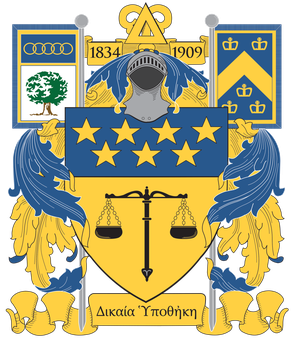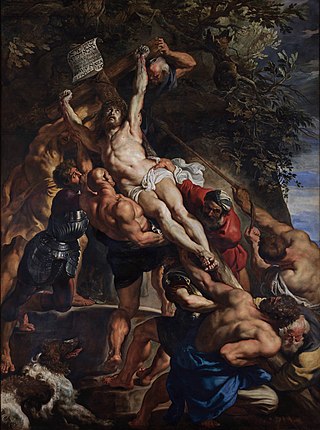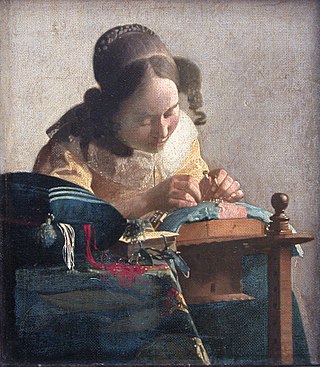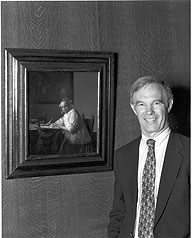Aelbert Jacobszoon Cuyp or Cuijp was one of the leading Dutch Golden Age painters,producing mainly landscapes. The most famous of a family of painters,the pupil of his father,Jacob Gerritszoon Cuyp (1594–1651/52),he is especially known for his large views of Dutch riverside scenes in a golden early morning or late afternoon light. He was born and died in Dordrecht.

Gerard ter Borch,also known as Gerard Terburg,was a Dutch Golden Age painter mainly of genre subjects. He influenced his fellow Dutch painters Gabriel Metsu,Gerrit Dou,Eglon van der Neer and Johannes Vermeer. According to Arthur K. Wheelock Jr.,Ter Borch "established a new framework for subject matter,taking people into the sanctum of the home",showing the figures' uncertainties and expertly hinting at their inner lives. His influence as a painter,however,was later surpassed by Vermeer.

Delta Upsilon (ΔΥ),commonly known as DU,is a collegiate men's fraternity founded on November 4,1834,at Williams College in Williamstown,Massachusetts. It is the sixth-oldest,all-male,college Greek-letter organization founded in North America. It is popularly and informally known as "DU" or "Delta U" and its members are called "DUs". Although historically found on the campuses of small New England private universities,Delta Upsilon currently has 76 chapters/colonies across the United States and Canada. A number of its buildings are listed on the National Register of Historic Places.

Pieter Bodding van Laer was a Dutch painter and printmaker. He was active in Rome for over a decade and was known for genre scenes,animal paintings and landscapes placed in the environs of Rome.

David C. Driskell was an American artist,scholar and curator recognized for his work in establishing African-American Art as a distinct field of study. In his lifetime,Driskell was cited as one of the world's leading authorities on the subject of African-American Art. Driskell held the title of Distinguished University Professor of Art Emeritus at the University of Maryland,College Park. The David C. Driskell Center at the University of Maryland,is named in his honor.

Thomas Willeboirts Bosschaert was a Dutch Republic-born Flemish Baroque painter.

Genre painting,a form of genre art,depicts aspects of everyday life by portraying ordinary people engaged in common activities. One common definition of a genre scene is that it shows figures to whom no identity can be attached either individually or collectively,thus distinguishing it from history paintings and portraits. A work would often be considered as a genre work even if it could be shown that the artist had used a known person—a member of his family,say—as a model. In this case it would depend on whether the work was likely to have been intended by the artist to be perceived as a portrait—sometimes a subjective question. The depictions can be realistic,imagined,or romanticized by the artist. Because of their familiar and frequently sentimental subject matter,genre paintings have often proven popular with the bourgeoisie,or middle class.

Saint Praxedis is an oil painting by Johannes Vermeer. This attribution has often been questioned. The painting is believed to be a copy of a work by Felice Ficherelli that depicts the early Roman martyr,Saint Praxedis or Praxedes.

Flemish Baroque painting was a style of painting in the Southern Netherlands during Spanish control in the 16th and 17th centuries. The period roughly begins when the Dutch Republic was split from the Habsburg Spain regions to the south with the Spanish recapturing of Antwerp in 1585 and goes until about 1700,when Spanish Habsburg authority ended with the death of King Charles II. Antwerp,home to the prominent artists Peter Paul Rubens,Anthony van Dyck,and Jacob Jordaens,was the artistic nexus,while other notable cities include Brussels and Ghent.

The Lacemaker is a painting by the Dutch artist Johannes Vermeer (1632–1675),completed around 1669–1670 and held in the Louvre,Paris. The work shows a young woman wearing a yellow bodice,holding up a pair of bobbins in her left hand as she carefully places a pin in the pillow on which she is making her bobbin lace.

The Allegory of Faith,also known as Allegory of the Catholic Faith,is a Dutch Golden Age painting by Johannes Vermeer from about 1670–1672. It has been in the Metropolitan Museum of Art in New York since 1931.
Theodore Ellis Stebbins,Jr. is an American art historian and curator. Stebbins is currently the Consultative Curator of American Art at the Harvard Art Museums.
Thomas "Tom" Woodward Lentz Jr. is an American art historian and curator. Lentz served as the Elizabeth and John Moors Cabot Director of the Harvard Art Museums from 2003 to 2015. He was the ninth director in its history.

Girl with a Flute is a small painting by Johannes Vermeer. It is currently believed to have probably been painted between 1669–1675. It is owned by the National Gallery of Art in Washington,D.C. along with three paintings attributed to Vermeer:Woman Holding a Balance,A Lady Writing a Letter,and Girl with a Red Hat.
Walter Arthur Liedtke,Jr. was an American art historian,writer and Curator of Dutch and Flemish Paintings at the Metropolitan Museum of Art. He was known as one of the world's leading scholars of Dutch and Flemish paintings. He died in the 2015 Metro-North Valhalla train crash.

Bearded Man with a Beret is a 1630 painting by the Dutch artist Jan Lievens. The painting of an old man is considered to be a stock character or a tronie. It is now in the National Gallery of Art in Washington D.C.

Self-Portrait is an oil painting on panel of c. 1629–1630 by the Dutch artist Jan Lievens. The work is held in a private collection,but was exhibited in Washington,D.C.,from 2008 to 2009,and worldwide with the Leiden Collection from 2017 and 2019.
Lara Yeager-Crasselt is an American art historian and curator of seventeenth-century Dutch and Flemish art. She studied art history Vassar College and the University of Maryland,where she received her PhD.
Ronni Baer is an American art historian and curator,recognized for her expertise in European paintings,particularly from the Dutch Golden Age and the Spanish Golden Age. Over her career,she has curated numerous critically acclaimed exhibitions and contributed extensively to the scholarship of 17th-century European art through her publications,lectures,and collaborative projects. Her work has broadened understanding of how Boston art collectors have contributed to the city's culture,and continues to influence the field of art history.













